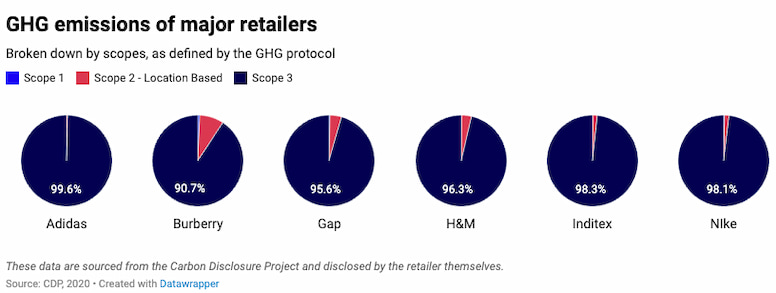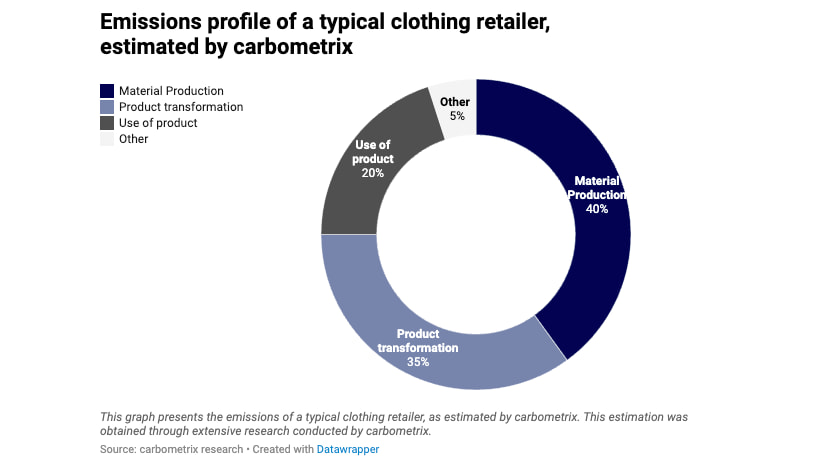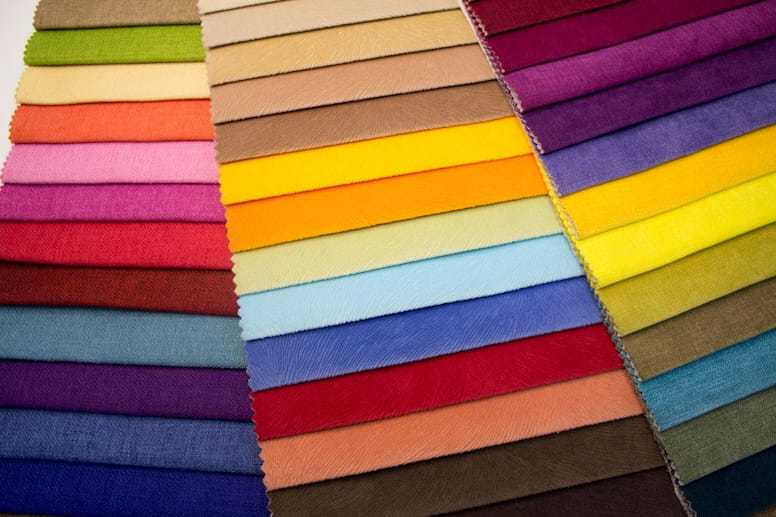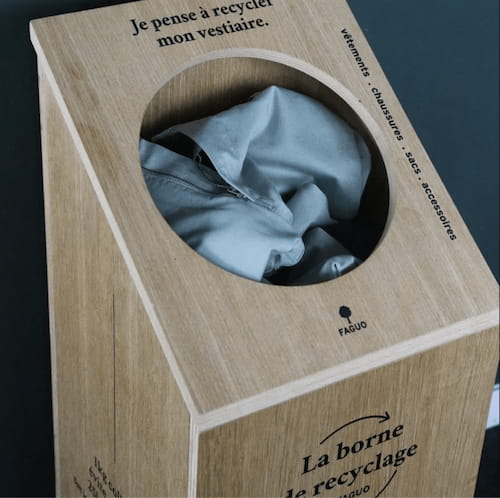Understanding the stakes
Fashion is one of the largest industries globally. It employs over 75 million people and generates 2 trillion dollars in sales annually. Furthermore, it is a growing industry. The rise of fast fashion in recent years has caused a sharp increase in the number of clothes sold yearly. From 60 billion units sold in 2000, sales almost doubled to 100 billion units in 2015.
The impacts of fashion can be felt on many levels: water usage, labor conditions, biodiversity, etc. Fashion is a resource-intensive industry that needs large quantities of non-renewable materials and which generates large quantities of waste. Focusing on greenhouse gas (GHG) emissions, its impact is crystal clear: the sector emitted 2 billion tons of GHG in 2018, 4% of the world’s total emissions. In other words, fashion emitted more GHG than France, Germany, and the UK combined. Fashion is one of the most polluting industries globally.
Through the 2015 Paris Agreement, governments committed to limiting global temperature rise to well below 2°C above pre-industrial levels and pursuing efforts to limit warming to 1.5°C. In 2018, the Intergovernmental Panel on Climate Change (IPCC) warned that global warming must not exceed 1.5°C above pre-industrial temperatures to avoid the catastrophic impacts of climate change.
As a significant contributor to climate change, the fashion industry needs to act now to cut its GHG emissions. Research shows that if the industry maintains the same pace of decarbonisation, its emissions in 2030 will be double of the maximum required to stay on the 1.5-degree pathway.
This article looks into concrete actions which can be taken by the industry to decarbonise its production. First, we analyse and present the most carbon-intensive processes of the industry’s value chain. Then, through an analysis of selected climate-conscious brands, we illustrate strategies to reduce GHG emissions.
Why does the fashion industry emit so much?
As mentioned above, fashion emitted 2 billion tons of GHG in 2018. Major retailers are taking action and joining various pledges to decarbonise their direct emissions. Direct emissions of retailers mostly have to do with the energy consumed to operate stores, warehouses, and offices. Many retailers have committed to reaching “net-zero emissions” from their direct operations before 2030.
While these efforts go in the right direction, the graph below shows their limitations. The emissions of each retailer are broken down into scopes, following the GHG Protocol. Scopes 1 & 2 are emissions caused by the assets owned by the company and the purchase of electricity. Scope 3 on the other hand is indirect emissions excluding the purchase of electricity. They are found upstream and downstream in the supply chain of these companies. As seen on the graph below, scope 3 emissions of major brands and retailers such as Adidas, Burberry, Gap, H&M, Inditex, or Nike represent the vast majority of their emissions, i.e. between 90 and 99%.

The data are clear: the only way for fashion retailers to achieve any degree of decarbonisation is by working on their supply chain, i.e. their scope 3 emissions.
These emissions are broad, but Carbometrix has identified the three most important areas where decarbonisation must take place:
Material production (approx. 40% of the sector’s emissions): whether fibers are natural (cotton, wool,..) or synthetic (polyester, elasthane,..), production processes are highly emissive
Product transformation (approx. 35%): the steps taken to transform fiber into garments (dyeing, cutting, sewing..) require large amounts of energy
Use of product (approx. 20%): the maintenance of a piece of clothing by consumers requires energy for washing, drying, ironing etc..

These three steps account for 95% of the sector’s emissions. Other parts of the value chain have been attracting much attention, such as transports or logistics. While these steps are also important, stakeholders must keep the orders of magnitude in mind. It is urgent that companies and consumers act to decarbonise first and foremost the producing, transforming, and wearing of clothes.
Fortunately, innovating companies have not waited to take the lead on these topics. The next section highlights actions taken by climate-conscious companies to decarbonise their activity.
1083: producing fully recycled and recyclable jeans
Named after the longest distance in km between two cities in France, 1083 was created in 2013 with the objective of relocating in France every step necessary to produce jeans. The company has been a pioneer in sustainable fashion, sourcing responsible materials since inception.

In 2018, 1083 pushed its engagement one step further. It launched “le jeans infini”: a 100% recycled and recyclable jeans. Sold through a mandatory deposit system (consumers get a portion of their money back if they bring back the jeans), the jeans are composed exclusively of recycled polyester. This allows 1083 to drastically reduce the carbon footprint of this product and add more circularity to their model.
Patagonia: adapting processes to decarbonise production
Conventional dyeing processes (using synthetic dyes) require large amounts of water and energy, resulting in waste and GHG emissions. Patagonia switched a selection of their products to “solution dyeing”, an approach that results in reduction in water use and CO2e emissions. Compared to conventional dyeing, this technique can achieve up to 95% reduction in GHG emissions.

This technique comes with certain disadvantages compared to traditional dyeing techniques. So far, Patagonia has applied this process to selected products. The brand has also invested resources in finding other low-carbon, dyeing techniques and has set-up rigourous energy-saving policies.
FAGUO: raising consumer awareness
Launched in 2009, FAGUO (Chinese for “French”) is a clothing brand whose mission is to “engage our generation against global warming”. Now an “entreprise à mission” under French law, FAGUO’s objectives can be summarised as follows: transparency, education, and carbon reduction. The brand has launched multiple initiatives to educate its clients on fair fashion and climate change.
In every single FAGUO selling point, clients will find second-hand corners where they can sell their used FAGUO clothes. Clients will also find recycling boxes there. FAGUO encourage their clients to “consume less but better”: they organise bimonthly repair workshops for their clients and they regularly post articles online on how to take care of their clothes. The Ellen MacArthur Foundation explains that “if the number of times a garment is worn were doubled, then GHG emissions would be 44% lower”. These initiatives give clients concrete opportunities to reduce the carbon footprint of their own clothes.

Conclusion
The takeaways from this article are clear. First, fashion is a highly-emitting industry which must urgently reduce its impact on the environment. Second, some companies are starting to act, looking for ways to reduce their products’ footprint.
Finding new ways of consuming is essential to decarbonise the fashion industry. All stakeholders must take action, from manufacturers to end-users. The ways clothes are made, transformed and worned must adapt to the transition. The industry must embrace the notions of circularity, repairability and durability. These changes will pave the way for more sustainable business models, renewed supply chains and eventually allow for the decarbonisation of the fashion industry.
Sources
https://unece.org/forestry/press/un-alliance-aims-put-fashion-path-sustainability
Euromonitor International Apparel & Footwear 2016 Edition (volume sales trends 2005–2015); World Bank, World development indicators – GD (2017)
https://sciencebasedtargets.org/about-us
https://emf.thirdlight.com/link/2axvc7eob8zx-za4ule/@/preview/1?o
